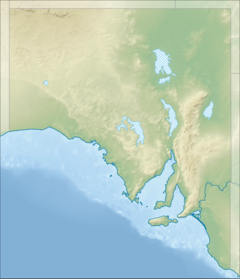geo.wikisort.org - River
The Hill River is an ephemeral river located in the Mid North region of the Australian state of South Australia.
| Hill | |
|---|---|
 An upstream view of the Hill River | |
 Location of the river mouth in South Australia | |
| Etymology | John Hill[1] |
| Location | |
| Country | Australia |
| State | South Australia |
| Region | Mid North |
| Physical characteristics | |
| Source | |
| • location | near Penwortham |
| • elevation | 341 m (1,119 ft) |
| Mouth | confluence with the Broughton River |
• coordinates | 33°31′39″S 138°37′34″E |
• elevation | 296 m (971 ft) |
| Length | 37 km (23 mi) |
| Basin size | 230 km2 (89 sq mi) |
| Basin features | |
| River system | Broughton River |
| Waterhole | Beetaloo Reservoir |
| [2] | |
Course and features
The Hill River rises about 3 kilometres (1.9 mi) east of Penwortham and then flows northward for about 37 kilometres (23 mi). Hill River runs roughly parallel to Hutt River, approximately 3 kilometres (1.9 mi) to the west. Near the town of Spalding Hill River becomes a tributary of the Broughton River shortly before the Hutt merges also.
The Hill River drains a catchment area of 230 square kilometres (89 sq mi). Flows which are intermittent, can result from either winter rains or local thunderstorms. The average annual observed flow in 2000–04 was 2,568 megalitres (90.7×106 cu ft).[3] Most of the catchment emanates from the Camels Hump Range and to a lesser degree from the Stony Range. Slab Hut Creek is amongst the more significant tributaries. The river has a low gradient which, combined with a broad and shallow catchment valley, renders it unsuitable as the site of any significant reservoir. In some areas the clearing of native vegetation has led to erosion and steep banks. The Hill River also gives its name to the locality of Hill River, which is within the District Council of Clare and Gilbert Valleys.[4]
History
This article may be confusing or unclear to readers. (January 2018) |
For over 100 years the date of European discovery and name origin for the river was confused. In the absence of proper research, several false attributions became accepted. According to (incorrect) state government sources, the river was discovered by an obscure 'William' Hill in 1838 and named for Rowland Hill, the secretary of the South Australian Colonization Commission from 1833 until 1837.[4]
According to Edward John Eyre, he discovered the river in 1839 and named it after explorer John Hill because he was "the gentleman who discovered its twin river, the Hutt".[1] John Hill was the first European to explore the nearby Clare Valley. He sighted and named several important rivers of South Australia, including the adjacent Hutt River and Wakefield River. A 1908 news article conversely credits the obscure William Hill with naming Hill River after himself.[5]
The issue was finally resolved in 2015 with the publication of John Hill : South Australia's Discoverer of Rivers, which emphatically concludes that Eyre discovered the river on 5 June 1839 and named it after John Hill, the explorer who discovered the Clare Valley
See also
- Rivers of South Australia
- Polish Hill River, South Australia
- Hill River, South Australia
- Hilltown, South Australia
References
- Eyre, Edward John (1984). Jill Waterhouse (ed.). Autobiographical Narrative, 1833–1839. Caliban Books. p. 205.
- "Map of Hill River, SA". Bonzle Digital Atlas of Australia. Retrieved 25 March 2017.
- Northern and Yorke Natural Resources Management Board (2009). Water Allocation Plan for the Clare Valley Prescribed Water Resources Area (PDF). Crystal Brook, South Australia: Northern and Yorke Natural Resources Management Board, Government of South Australia. p. 4. ISBN 978-0-9806143-1-2.
- "Search result for "Hill River, STRM" (Record # SA0007485)". Department of Planning, Transport and Infrastructure, Government of South Australia. Retrieved 12 November 2015.
Derivation of Name: Rowland Hill; Other Details: Recorded as being discovered by William Hill in 1838. Rowland Hill was at that time Secretary to the SA Association. He later became famous for pastoral activities. Shown on Captain Frome's 1842 Plan as River Hill.
- "NOMENCLATURE OF SOUTH AUSTRALIA. THE ORIGIN OF NAME8. No. XIII: AN ALPHABETICAL REVIEW. An Early Plea for Closer Settlement". South Australian Register. 13 June 1908. p. 9.
The Hutt and Hill Rivers were discovered and named by William Hill in 1839 — the one after Sir William Hutt, M.P. one of Lord Glenelg's nominees among the South Australian Colonization Commissioners, and the other after himself.
Другой контент может иметь иную лицензию. Перед использованием материалов сайта WikiSort.org внимательно изучите правила лицензирования конкретных элементов наполнения сайта.
WikiSort.org - проект по пересортировке и дополнению контента Википедии